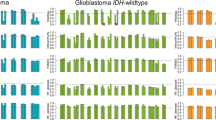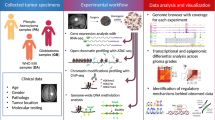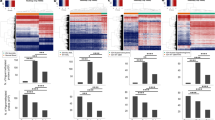Abstract
To identify the CpG islands differentially methylated in human glioma, we performed restriction landmark genomic scanning with a CpG methylation-sensitive enzyme. We found 12 spots, the intensity of which was entirely lost or decreased in both the human glioma tissues examined as compared with that in matched normal lymphocytes, indicating aberrant methylation of these CpG islands in gliomas. The expression of RFX1, one of the genes associated with the methylated CpG islands, was frequently decreased in human glioma cell lines and tissues. We also demonstrated that the isolated CpG island located in the seventh intron of the RFX1 gene had enhancer activity and was hypermethylated in all of the glioma tissues and cell lines analysed, but not in normal brains or lymphocytes. Treatment of glioma cells with a demethylating agent, 5-azacytidine, resulted in the expression of RFX1, indicating that the silencing of the RFX1 gene may be attributable to its methylation. RFX1 has been implicated in transcriptional downregulation of the proto-oncogene c-myc. By expression of the RFX1 gene, the cellular proliferative activity of glioma cells was suppressed. Taken together, these results suggest that the RFX1 gene may be epigenetically silenced in human gliomas and involved in glioma tumorigenesis.
This is a preview of subscription content, access via your institution
Access options
Subscribe to this journal
Receive 50 print issues and online access
$259.00 per year
only $5.18 per issue
Buy this article
- Purchase on Springer Link
- Instant access to full article PDF
Prices may be subject to local taxes which are calculated during checkout






Similar content being viewed by others
References
Blin N and Stafford DW . (1976). Nucleic Acids Res., 3, 2303–2308.
Chen L, Smith L, Johnson MR, Wang K, Diasio RB and Smith JB . (2000). J. Biol. Chem., 275, 32227–32233.
Costello JF, Fruhwald MC, Smiraglia DJ, Rush LJ, Robertson GP, Gao X, Wright FA, Feramisco JD, Peltomaki P, Lang JC, Schuller DE, Yu L, Bloomfield CD, Caligiuri MA, Yates A, Nishikawa R, Su Huang H, Petrelli NJ, Zhang X, O’Dorisio MS, Held WA, Cavenee WK and Plass C . (2000). Nat. Genet., 24, 132–138.
Di Cristofano A, Pesce B, Cordon-Cardo C and Pandolfi PP . (1998). Nat. Genet., 19, 348–355.
Emery P, Durand B, Mach B and Reith W . (1996). Nucleic Acids Res., 24, 803–807.
Frommer M, McDonald LE, Millar DS, Collis CM, Watt F, Grigg GW, Molloy PL and Paul CL . (1992). Proc. Natl. Acad. Sci. USA, 89, 1827–1831.
Fults D, Brockmeyer D, Tullous MW, Pedone CA and Cawthon RM . (1992). Cancer Res., 52, 674–679.
Gajiwala KS, Chen H, Cornille F, Roques BP, Reith W, Mach B and Burley SK . (2000). Nature, 403, 916–921.
Gardiner-Garden M and Frommer M . (1987). J. Mol. Biol., 196, 261–282.
Hatada I, Hayashizaki Y, Hirotsune S, Komatsubara H and Mukai T . (1991). Proc. Natl. Acad. Sci. USA, 88, 9523–9527.
Humphrey PA, Wong AJ, Vogelstein B, Friedman HS, Werner MH, Bigner DD and Bigner SH . (1988). Cancer Res., 48, 2231–2238.
Itano O, Ueda M, Kikuchi K, Shimazu M, Kitagawa Y, Aiura K and Kitajima M . (2000). Oncogene, 19, 1676–1683.
Katan-Khaykovich Y and Shaul Y . (2001). Eur. J. Biochem., 268, 3108–3116.
Lindsay S and Bird AP . (1987). Nature, 327, 336–338.
Maegawa S, Yoshioka H, Itaba N, Kubota N, Nishihara S, Shirayoshi Y, Nanba E and Oshimura M . (2001). Mol. Carcinogen., 31, 1–9.
Meehan RR, Lewis JD and Bird AP . (1992). Nucleic Acids Res., 20, 5085–5092.
Melki JR, Vincent PC and Clark SJ . (1999). Cancer Res., 59, 3730–3740.
Nakamura M, Yonekawa Y, Kleihues P and Ohgaki H . (2001). Lab. Invest., 81, 77–82.
Rasheed BK, Wiltshire RN, Bigner SH and Bigner DD . (1999). Curr. Opin. Oncol., 11, 162–167.
Saito Y, Kanai Y, Sakamoto M, Saito H, Ishii H and Hirohashi S . (2001). Hepatology, 33, 561–568.
Sekita N, Suzuki H, Ichikawa T, Kito H, Akakura K, Igarashi T, Nakayama T, Watanabe M, Shiraishi T, Toyota M, Yoshie O and Ito H . (2001). Jpn. J. Cancer Res., 92, 947–951.
Sidransky D, Mikkelsen T, Schwechheimer K, Rosenblum ML, Cavanee W and Vogelstein B . (1992). Nature, 355, 846–847.
Siegrist CA, Durand B, Emery P, David E, Hearing P, Mach B and Reith W . (1993). Mol. Cell. Biol., 13, 6375–6384.
Smiraglia DJ, Fruhwald MC, Costello JF, McCormick SP, Dai Z, Peltomaki P, O’Dorisio MS, Cavenee WK and Plass C . (1999). Genomics, 58, 254–262.
Umezawa A, Yamamoto H, Rhodes K, Klemsz MJ, Maki RA and Oshima RG . (1997). Mol. Cell. Biol., 17, 4885–4894.
Whang YE, Wu X, Suzuki H, Reiter RE, Tran C, Vessella RL, Said JW, Isaacs WB and Sawyers CL . (1998). Proc. Natl. Acad. Sci. USA, 95, 5246–5250.
Yamada KM and Araki M . (2001). J. Cell Sci., 114, 2375–2382.
Zardo G, Tiirikainen MI, Hong C, Misra A, Feuerstein BG, Volik S, Collins CC, Lamborn KR, Bollen A, Pinkel D, Albertson DG and Costello JF . (2002). Nat. Genet., 32, 453–458.
Acknowledgements
We thank Mr Muramatsu and Mr Iizuka (Keio University School of Medicine) for their technical support. We are also grateful to Dr W Reith (University of Geneva Medical School) for providing us with the pHRFX1 plasmid. This work was supported by grants from grant-in-aid for Scientific Research from the Japanese Ministry of Education, Culture, Sports, Science and Technology (MT), the Keio University Medical Science Fund (MT), and grand-in-aid for Scientific Research on Priority Areas from the Japanese Ministry of Education, Culture, Sports, Science and Technology (MU).
Author information
Authors and Affiliations
Corresponding author
Rights and permissions
About this article
Cite this article
Ohashi, Y., Ueda, M., Kawase, T. et al. Identification of an epigenetically silenced gene, RFX1, in human glioma cells using restriction landmark genomic scanning. Oncogene 23, 7772–7779 (2004). https://doi.org/10.1038/sj.onc.1208058
Received:
Revised:
Published:
Issue Date:
DOI: https://doi.org/10.1038/sj.onc.1208058
Keywords
This article is cited by
-
RFX1 downregulation contributes to TLR4 overexpression in CD14+ monocytes via epigenetic mechanisms in coronary artery disease
Clinical Epigenetics (2019)
-
IL-6/STAT3 pathway induced deficiency of RFX1 contributes to Th17-dependent autoimmune diseases via epigenetic regulation
Nature Communications (2018)
-
Identifying survival-associated modules from the dysregulated triplet network in glioblastoma multiforme
Journal of Cancer Research and Clinical Oncology (2017)
-
Obatoclax analog SC-2001 inhibits STAT3 phosphorylation through enhancing SHP-1 expression and induces apoptosis in human breast cancer cells
Breast Cancer Research and Treatment (2014)
-
Functional analysis of HOXD9 in human gliomas and glioma cancer stem cells
Molecular Cancer (2011)



